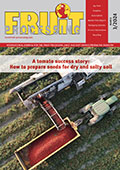Brazilian inventories may be critical again by June/19
The smaller crop forecast for the Brazilian citrus belt in 2018/19 (São Paulo and Triângulo Mineiro), at 288.29 million 40.8-kilo boxes (almost 30 % lower than the 2017/18 season), should result in critical inventories at processors from São Paulo State on June 30 2019.

The smaller crop forecast for the Brazilian citrus belt in 2018/19 (São Paulo and Triângulo Mineiro), at 288.29 million 40.8-kilo boxes (almost 30 % lower than the 2017/18 season), should result in critical inventories at processors from São Paulo State on June 30 2019. In 2017//18, despite the larger crop, supply was not significant, only enough to slightly increase the low inventories from 2016/17.
Thus, by June 2019, inventories should be 50 % smaller, considering forecasts for the 2018/19 crop. Data released by CitrusBR (Brazilian Association of Citrus Exporters) on May 22 estimated ending stocks of Frozen Concentrate Orange Juice (FCOJ) Equivalent from 55.9 thousand tons to 154.7 thousand tons in June 2019. CitrusBR forecasts were based on the volumes crushed in the 2017/18 season, at around 243.4 million 40.8-kilo boxes, 34% down compared to the 370 million boxes crushed in the current season (2017/18).
Cepea calculations, however, indicate inventories are more likely to be from 55.9 to 102.6 thousand tons, not reaching the maximum level estimated by CitrusBR (at 154.7 thousand tons). To forecast that scenario, CitrusBR considered exportations will keep firm. Now, if processors do not aim to reduce inventories that much, the volume shipped may decrease in 2018/19.
The 2017/18 ending stocks of orange juice should be at 305.9 thousand tons by June 30 2018, 20.3 % up compared to that forecast in February/18. The positive 2017/18 harvesting ensured comfortable inventories to processors this year.
n general, the global demand for orange juice has been firm, mainly from the United States, Considering Florida crop may be 35 % lower, according to the USDA, juice availability should continue low in the next season (2019/20).
Regarding growers’ revenue, forecasts for the short-term indicate prices may not change much. Most farmers have already closed contracts with processors, and even if bidding prices rise from now onward, only a few growers would have fruits available for trading. Besides, productivity should be low, since the number of boxes produced per hectare results in a higher cost per unit and lower margins.
BRAZILIAN MARKET – Although the trading pace in the Brazilian citrus market slowed down in the second week of June, the supply of oranges in the stages demanded by the in natura market from São Paulo decreased, since delivery of these fruits to processors stepped up early in the month, when truckers’ strike ended. Thus, in the first fortnight of June, pear orange quotes averaged 25.52 BRL per 40.8-kilo, on tree, 1 % down compared to that in the same period of May.
As for tahiti lime, harvesting started again (after the end of truckers’ strike), pressing down quotes as well. Besides, demand was weakened in the domestic market. In the first fortnight of June, tahiti lime quotes averaged 36.36 BRL per 27-kilo box, harvested, 26.1 % down compared to that between May 1 and 15.









